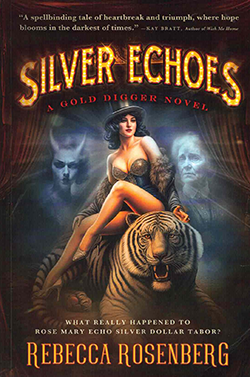Silver Echoes by Rebecca Rosenberg; Lion Heart Publishing; © 2025; ISBN 9781732-969964; 336 pages plus appendices; $15.99. Publication date May 20.

 SAN DIEGO – Rebecca Rosenberg’s account of the life of Rose Mary Echo Silver Dollar Tabor is fictional, although such an improbably named person was the actual daughter of a Colorado silver baron, former Republican U.S. Sen. Horace Tabor, and his second wife, Elizabeth “Baby Doe” McCourt Tabor.
SAN DIEGO – Rebecca Rosenberg’s account of the life of Rose Mary Echo Silver Dollar Tabor is fictional, although such an improbably named person was the actual daughter of a Colorado silver baron, former Republican U.S. Sen. Horace Tabor, and his second wife, Elizabeth “Baby Doe” McCourt Tabor.
The story is set following the establishment of the national gold standard, prompting the devaluation of silver and the financial collapse of the Tabor empire. Now widowed, Baby Doe lives humbly near the Matchless silver mine. Silver Dollar Echo, a beauty, tries to restore the family’s fame and fortune through a show business career.
The book’s chapters alternate between Silver Dollar narrating her life story from 1915 to 1925 and her mother Baby Doe’s reminiscences in 1932, the year that Silver Dollar, a movie starring Edward G. Robinson and Bebe Daniels, had its premiere in Leadville, Colorado, in an opulent movie palace that had been built in their heyday by the Tabor family.
The novel’s plot lines are tied together by the character of Carl, the movie’s screenwriter who earlier in his life had been Silver Dollar’s too-shy admirer. To provide the movie with verisimilitude, Carl interviews Baby Doe frequently about the Tabor family saga, forming a friendship with the woman who could have been his mother-in-law.
In the novel, trauma-induced Dissociative Identity Disorder (DID) causes Silver Dollar’s alter ego, Echo, to lead a dissolute life involving sex, bootleg liquor, and drugs. Silver Dollar and Echo are aware that they share the same body, but Silver Dollar is only vaguely aware of the things that Echo does when she is liberated from Silver Dollar’s troubled brain. The two personalities fight each other for mastery.
Rather than obtaining stardom in the movies, Silver Dollar works as a tiger tamer in a mob-controlled Colorado nightclub, wowing audiences with the way she puts the big cats through routines in which she risks her life.
The novel disputes biographer David Karsner’s 1932 account in Silver Dollar, the Story of the Tabors, that Silver Dollar died in a 1925 accident in which she drunkenly spilled a large kettle of boiling water on herself.
Author Rosenberg’s novel is a page turner despite biting off more than she could chew. Her writing about the rise of the Ku Klux Klan seems to be thrown haphazardly into the book, rather than advancing its plot. World War One is a plot device explaining how Carl and Silver Dollar became separated, but the war’s impact on either character is not explored. These are missed opportunities for a writer of historical fiction.
*
Donald H. Harrison is publisher and editor of San Diego Jewish World.